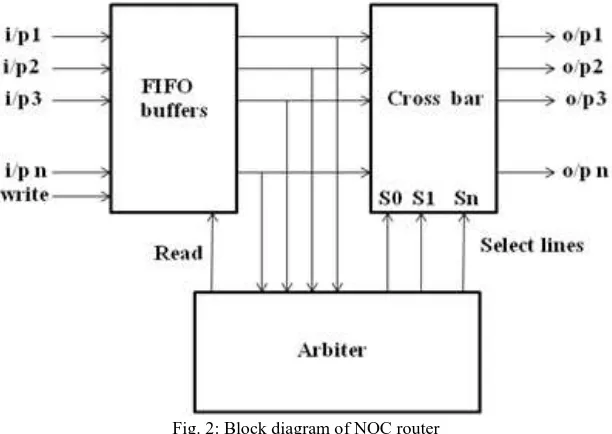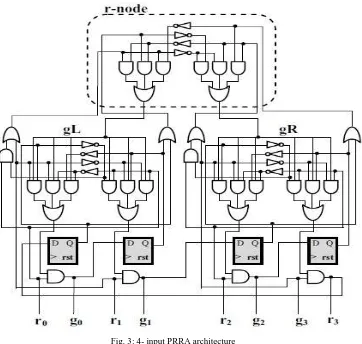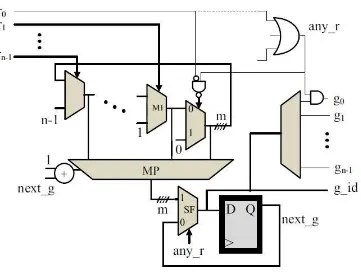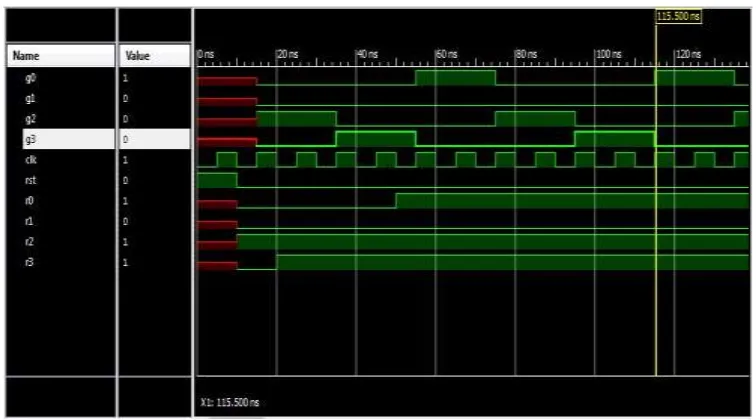IJSTE - International Journal of Science Technology & Engineering | Volume 2 | Issue 12 | June 2016 ISSN (online): 2349-784X
Design of Index based Round Robin Arbiter for
NOC Router
Kavyashree A Mahesh Neelagar
PG Student Assistant Professor
Department of VLSI Design & Embedded Systems Department of VLSI Design & Embedded Systems Center for PG Studies, Visvesvaraya Technological University,
Belagavi, Karnataka, India
Center for PG Studies, Visvesvaraya Technologica University, Belagavi, Karnataka, India
Abstract
Network-on-chip (NOC) is one of the scalable on-chip communication systems which are used to meet the communication demands of large number of System on chip (SoC) cores. In NOC architecture, router is a main factor which transmits data from source to destination. In router design, arbiter is important due to its performance and efficiency of NOC systems. Round robin arbiter (RoR) is a type of arbiter used in router; there are 3 different existing designs of round robin arbiter such as Parallel round robin arbiter (PRRA), Improved PRRA (IPRRA) and High speed and decentralized round robin arbiter (HDRA) and there is a high demand for low power consumption, low delay and high speed operations. Hence, in this project we proposed an Index based round robin arbiter (IRRA), which works with an index format of the input ports to reduce the power consumption, delay of the circuit. The proposed method is compared with PRRA and HDRA for delay and power consumption. Finally, the minimum number of optimizing parameters such as delay and power consumption is achieved. The design of Index based round robin arbiter is coded in Verilog, synthesized and simulated in Xilinx ISE Design Suite 12.4 tool.
Keywords: Round robin arbiter, IRRA, Delay, Power consumption
________________________________________________________________________________________________________
I. INTRODUCTION
In today’s VLSI trend, area and speed are big challenges on single chip, where many number of processing elements (PEs) are placed on System on chip (SOC). There are different types of interconnection schemes that are currently in use like crossbar, buses and NOCs. NOC is used to improve the scalability and power reduction in a complex circuit. In Network on chip, router is the main factor which routes the input data from source to destination. During routing if many inputs requests for the same destination then arbiter is the one which selects the inputs according to their provided priorities. Round robin arbiter is a type of arbiter which works under the principle of recent served should have least priority in the next cycle or next round of arbitration.
Using round robin arbiter algorithm there are different types of arbiters which are implemented already, some of those are Parallel round robin arbiter (PRRA), Improved parallel round robin arbiter (IPRRA) and (HDRA) High speed and decentralized round robin arbiter. We are proposed an Index based round robin arbiter (IRRA) which has inputs in the form of index format to reduce the delay and power consumption. According to the arrangement of indexed inputs the outputs are executed. Here we are considering two previously designed round robin arbiters such as Parallel round robin arbiter (PRRA) and High speed and decentralized round robin arbiter (HDRA) to compare with proposed Index based round robin arbiter (IRRA) for delay and power consumption.
II. BASIC CONCEPT OF NETWORK ON CHIP
Network-on-chip (NOC)
Fig. 1: Typical NOC architecture
Router
The heart of on-chip network is the router, which is responsible for performing the crucial task of coordinating the data flow from requested source to destination. NOC router consists of three main blocks they are crossbar, buffer and arbiter which is shown in below figure 2.
Fig. 2: Block diagram of NOC router
Design of Index based Round Robin Arbiter for NOC Router
(IJSTE/ Volume 2 / Issue 12 / 044)
III. METHODOLOGY
Parallel round robin arbiter
Fig. 3: 4- input PRRA architecture
Above figure 3 represents the Parallel round robin arbiter (PRRA) which is based on simple binary search algorithm. Implementation of binary search algorithm helps in hardware implementation and it is easy to implement in hardware. PRRA is a combinational circuit with an implementation of binary tree structure. PRRA arbitration is divided into up-trace and down-trace. Up-trace is one of the subprocess of collecting the input requests along with their priorities information of round robin. Down-trace is another sub process which is used for the decision making with the information collected about input request and priorities in up-trace. Up-trace is further divided into grant left (gL) and grant right (gR).
High speed and decentralized round robin arbiter
Fig. 4: 4-input HDRA architecture
Existing index based round robin arbiter
Fig. 5: Circuit of existing IRRA
Design of Index based Round Robin Arbiter for NOC Router
(IJSTE/ Volume 2 / Issue 12 / 044)
output of the mux MP is given as input to the SF mux which has another input as 0 and select line is the ORing of all inputs. D flip flop stores the data and gives the output as next_g. the output of D flip flop is fed back to MP mux to identify currently executed input and it is also incremented by 1 to indicate that to give execution chance for the next input.
The output of SF mux is considered as the output of the design but it is in a single output which is called as grant index (g_id). This gives only single output but not n outputs as that of inputs hence g_id is applied as input to the demux which intern decode the output into n outputs. If there is no input request then all the inputs are operated with OR gate and ANDed with grant signals to avoid the errors from the previous output. Hence to avoid the additional ANDing of signal with grant signal, new IRRA is proposed which reduces the delay, power consumption and area than an existing IRRA.
IV. PROPOSED METHOD
Figure 6 is the block diagram of proposed index based round robin arbiter and figure 7 is the circuit diagram of proposed IRR A. Each input are in the index format which is applied to each individual multiplexer. Number of outputs from all individual multiplexers is sorted out to a single output by a mux MP. In a proposed IRRA, instead of demux for decoding of output decoder is used. Decoder gives the error free output when there is no input request whereas demux was sending with some error of the previous output. Any_r signal is the ORing of all the inputs.
This design of IRRA reduces the delay and power consumption of the previous design.
Fig. 6: Block diagram of proposed IRRA Fig. 7: Circuit diagram of proposed IRRA
V. RESULTS
Following are the obtained results of proposed IRRA and comparison table
B. Comparison table
DESIGN DELAY POWER CONSUMPTION MAXIMUM FREQUENCY NO OF REGISTER NO OF LUT
PRRA 1.633ns 0.042W 612.276MHz 4 8
HDRA 2.386ns 0.040W 419.182MHz 4 12
IRRA 1.562ns 0.039W 640.266MHz 4 11
VI. CONCLUSION
We have presented an Index based round robin arbiter for Network-on-chip (NOC) router in FPGA design. We proved that our proposed design achieves a strong and well defined arbitration for a 4 input pattern and compared with some other previous designs such as Parallel round robin arbiter (PRRA) and High speed and decentralized round robin arbiter (HDRA) for delay and power consumption. There is a 4.34% of delay and power consumption improvement with PRRA and 34.53% of delay and power consumption improvement with HDRA. The main difference of our proposed method is its index format of the input ports. The index based round robin arbiter is simple in architecture, fast with less number of hardware components and it consumes less power as on with previous designs.
ACKNOWLEDGEMENT
Thanks to Mr. Mahesh Neelagar for their valuable guidance.
REFERENCE
[1] V.Soteriou, R.S. Ramanujam, B. Lin, Li-Shiuan Peh. A High-Throughput Distributed Shared-Buffer NoC Router. IEEE Computer Architecture Letters, vol.
8, no. 1, pp. 21-24, Jan.-June 2009, doi:10.1109/LCA. 2009.5.
[2] Yun-Lung Lee, Jer Min Jou, and Yen-Yu Chen, "A High-Speed and Decentralized Arbiter Design for NoC," Proc. IEEE/ACS Int. Conf. on Computer Systems and Applications, Rabat,2009 pp. 350-353.
[3] Z. Fu and Xiang Ling, "The design and implementation of arbiters for Network-on-chips," Proc. 2nd Int. Conf. Industrial and Information Systems, Dalian,
2010 pp. 292-295.
[4] G. Xiaopeng, Z. Zhe, and L. Xiang, “Round robin arbiters for virtual channel router,” in Computational Engineering in Systems Applications, IMACS
Multiconference on, vol. 2, Oct. 2006, pp. 1610–18614.
[5] IPRRA for high speed, low power Noc router, Vikrant A. Bute1, Devendra S. Chaudhari2, (IJCSIT) International Journal of Computer Science and
Information Technologies, Vol. 5 (3), 2014.
[6] The Behavior of Round Robin Arbiter in NOC Architecture, Suyog K. Dahule, Reetesh V. Golhar, Mangesh D. Ramteke, International Journal of
Engineering and Innovative Technology (IJEIT) Volume 3, Issue 5, November 2013.
[7] W. J. Dally and B. Towles. “Arbitration,” In: Principles and Practices of Interconnection Networks. Morgan Kaufmann Publishers, 2004, pp. 349-362.
[8] S. Q. Zheng and Mei Yang, "Algorithm-Hardware Codesign of Fast Parallel Round-Robin Arbiters", IEEE Trans Parallel and Distributed Systems, vol. 18,
January 2007, pp. 84-95.
[9] S. S. Mehra, R. Kalsen and R. Sharma, “FPGA based Network-on- Chip Designing Aspects” National Conference on Advanced Computing and
Communication Technology, ACCT-10, 828.



